Summary:
This analysis is intended to help Canadian business executives and policy makers enhance their understanding of current market trends, the latest key performance indicators (KPI), and best practices in CRM that improve domestic and international competitiveness across industries.
- State of Customer Relationship Management (PDF, 5,883 KB, 30 pages)
- To obtain a copy of this publication or an alternative format (Braille, large print, etc.)
- Permission to reproduce
Highlights
In today's complex business environment, the extent to which manufacturing and services firmscan effectively attract and retain profitable customers is a key determinant of theircompetitiveness. Customer relationship management (CRM) is a cross-functional strategicprocess utilized by firms to manage and develop their interactions with current and potentialcustomers.
CRM is an innovation- and technology-driven process. To efficiently and effectively respond to rapid changes in customer demand, firms must have access to timely and accurate information regarding their current and potential customers. The integration of CRM technologyFootnote I into agreater CRM strategy provides firms with appropriate tools to respond to this challenge and the potential to enhance business operations throughout the sales cycle.
Across industry sectors, firms are prioritizing their investment in CRM — through both in-house and outsourcing investment — while integrating CRM with their commercialisation strategies to develop their revenue streams through new and existing markets. It is important that firms and policy makers have the ability to access and utilize strategic information and performanceindicators enabling them to focus on CRM initiatives and strategies that deliver businessbenefits.
Industry Canada has partnered with Canadian Manufacturers and Exporters (CME), CanadianServices Coalition (CSC) an affiliate of the Canadian Chamber of Commerce (CCC), CanadianAdvanced Technology Alliance (CATA), and the Program for International Competitiveness atMcGill University's Desautels Faculty of Management to review this valuable core businessfunction. By collecting insights from industry, academia and international research organizations, and using economic analysis conducted by Industry Canada, this industry-academia-government partnership has produced a complete user / service profile of CRM in Canada, summarized here in this report. This unique analysis is intended to help Canadian business executives and policy makers enhance their understanding of current market trends, the latest key performance indicators (KPI), and best practices in CRM that improve domestic and international competitiveness across industries.
Key findings
- CRM represented $116 billion of investment and employed 502,000 people in 2009 inCanada.Footnote II
- CRM is a value-added core business function along with logistics and product design and development, and plays a vital role in the commercialisation of manufactured goods andrelated services.
- Targeted advertising, market research and skills development are among the leadingCRM activities used by small and medium-sized enterprise (SME) manufacturers that successfully increased their exports of recent innovative products.
- The allocation between in-house and outsourced CRM investment by the differentindustry sectors has not changed significantly over the past several years.
- CRM outsourcing to service providers is forecasted to increase by 15 percent between 2009 and 2012, to reach $53.4 billion.
- The highest concentrationFootnote III of CRM service providers is in large metropolitan cities as these service providers are often established near the headquarters of their large corporate clients.
- Skills development within market research, marketing and promotion, and businessdevelopment has been expanding beyond domestic and traditional CRM activities toinclude areas such as international market entry strategies and international tradepractices and regulations.
- Although CRM technology can provide firms a competitive advantage in themarketplace, there is only limited adoption across sectors regardless of firm size.
- Best-in-Class (BiC)Footnote IV firms are more likely to measure the performance of their customer relationship initiatives, utilize advanced lead management solutions and collaborationtools, and implement skills development to facilitate the achievement of business goals.
Background
In a global economy, the ability to attract, establish, develop and retain long-term profitablerelationships with customers is integral to the strategic advantage of Canadian manufacturing andservices firms. Customer relationship management (CRM) is a cross-functional core processutilized by firms to deliver value through their relationships with current and potential customers.CRM strategies can involve all client-facing departments and beyond, to increase profitability and customer satisfaction.
The CRM process is a cycle of continuous improvement over time with iterative feedback and recurring input from a firm's internal and external stakeholders. The CRM cycle involves three stages: market research and marketing; business development; and customer feedback and support (Figure 1).
Figure 1—Customer relationship management cycle1
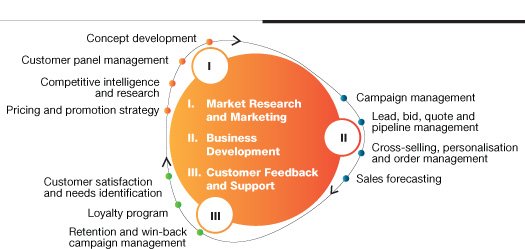
Phase I: market research and marketing
The process begins with performing market research and marketing for a product or service.Developing a concept for commercialisation and marketing is integral at this stage and can occurin concert with product design and development.Footnote V Determining potential market size while developing appropriate promotion and pricing strategies are key activities.
Phase II: business development
Once the marketing strategy has been developed, it is implemented during the businessdevelopment stage, where sales generation occurs. Key components of this stage can includeeffective lead, bid, quote and pipeline management; cross-selling, personalisation and ordermanagement; sales forecasting; and logistics and distribution strategy.Footnote VI
Phase III: customer feedback and support
Finally, identifying customer satisfaction and future needs takes place during the customerfeedback and support stage. This process leads to improvements and new opportunities for thenext iteration of the cycle.
The activities within the CRM cycle are integral for successful commercialisation. Targetedadvertising, market research and skills development are among the leading CRM activities usedby small and medium enterprise (SME) manufacturersFootnote VII that successfully increased their exports of recent innovative products (Figure 2). In addition, those same firms were more than twice as likely to provide training on how to market the product as those SME manufacturers that were unsuccessful in increasing their exports of recent innovative products. Further, providing customer specific services enable exporters to differentiate their global offering and increase profit margins in highly competitive markets.
Figure 2—Leading CRM activities by SME manufacturers that successfully increased exports of recent innovative products.
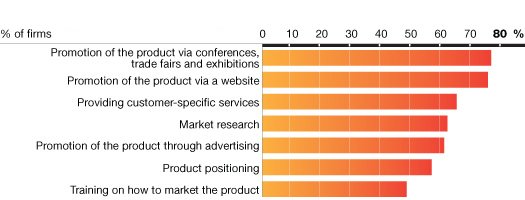
Overall, Canadian manufacturers and service providers can benefit from quality and timelyinformation on CRM trends and performance indicators. This strategic information can be usedto identify best practices, develop benchmarks, and justify investment and innovation decisionsfor firms while helping inform policy makers of current and future industry trends and needs.
This report provides insights on:
- CRM investment by industrial sector;
- Growth forecast of CRM outsourcing;
- CRM service industry profile: geographic distribution and revenue growth;
- Skills and employment in CRM;
- Adoption of advanced CRM technologies and processes; and
- Business benefits of adopting advanced CRM technologies and processes.
Customer relationship management investment
Firms can conduct CRM through a combination of in-house and outsourced investment. In-house CRM is defined as the internal investment a sector makes in terms of related personnel and capital in Canada, while outsourced CRM is defined as the purchase of CRM activities from service providers in Canada or abroad. A comprehensive view of CRM activity in Canada can be gained by examining investment volume combined with investment intensity. Investment volume reflects the quantity of CRM activity in a sector, while investment intensity represents the proportion of resources allocated to CRM activities.
Customer relationship management investment volume
CRM investment across wholesale, manufacturing, finance and insurance, retail, and logistics and transportation services sectors was $116 billion in 2009.Footnote VIII, The wholesale sector made the largest in-house CRM investment in Canada, committing $37.8 billion (Figure 3). This significant in-house CRM investment is due to the wholesale sector's main value-added activity of representing manufacturers' products. As such, priorities for the wholesale sector's investmentinclude sales force development and commitment toward expanding inside sales channels.
Figure 3 — CRM investment volume (2009) ($ billions)
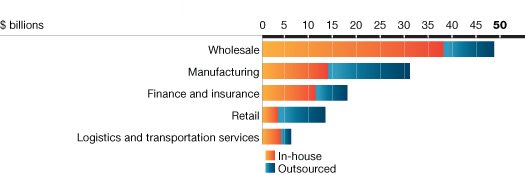
The establishment of product and brand recognition in the marketplace through advertising andpromotion is a key CRM focus within the manufacturing sector. Manufacturers often rely on thespecialized expertise and agility of advertising agencies to drive their marketing and promotionactivities, contributing to the sector committing 56 percent of its CRM investment (or $17.3 billion) toward outsourcing.
Customer relationship management investment intensity
CRM investment intensityFootnote IX reflects the commitment of resources allocated to CRM activitieswithin a sector. The variability of CRM investment intensity across sectors is influenced bydifferent business models inherent to each sector. Again, given the business model of thewholesale industry, a larger proportion of their sales revenue is expected to be reinvested inCRM (10.3 percent) compared to other sectors (Figure 4).
Figure 4—CRM investment intensity (2009) ( percent of sales)
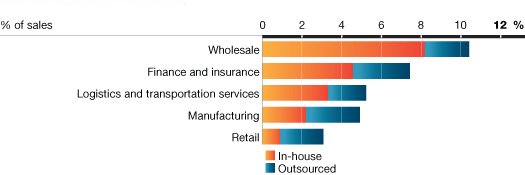
The lower CRM investment intensity found in the retail sector is partially attributable to theconsiderable amount of CRM activity performed by consumer product goods (CPG)manufacturers and wholesalers promoting and supporting the products carried by retailers. Theproduct and customer support provided to end consumers by CPG manufacturers is only part ofthe CPG manufacturers CRM after-sales strategy. The business-to-business (B2BB2B) component of CPG manufacturers' after-sales support focuses on logistics and order processing and typically operates separately from the end consumer support.
The main shift in sector rankings for investment volume versus intensity is due to the increasedimportance of CRM activities within the finance and insurance and the logistics andtransportation services sectors, compared to the manufacturing sector. Competing within sectorsin which they neither produce, represent nor sell tangible goods, the finance and insurance andthe logistics and transportation services industry players focus on CRM activities to differentiatethemselves from their competitors.
Customer relationship management investment trends
While the recent economic downturn affected the business plans and strategies of firms,investment in CRM has remained a priority. Across sectors, firms are increasing their focus onexpanding their sales and offerings through inside channels as a means to control costs and driveshort-term results. Overall, sectors have maintained or increased their CRM investment to retaintheir current customers and market share (Figure 5).
Figure 5—CRM investment trend
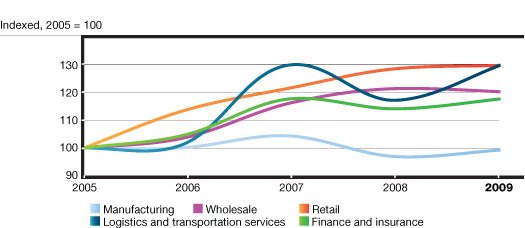
During the mid-2000s, the logistics and transportation services sector anticipated a continued eraof high growth and firms invested heavily in CRM to attempt to capitalize on future businessopportunities. However, the recent economic downturn left the sector with excess capacity due tovolume reductions in 2008. Industry players reacted to the significant drop in volume and weakforecasts in the second half of 2008 by adjusting their internal efforts in marketing and salesforce in some key segments. By mid-2009, firms cited an improvement in volume as well asgrowth forecasts as a driver for them to reinvest internally in CRM.
Meanwhile, the manufacturing sector has maintained its CRM investment level over the pastseveral years to minimize the impact of sales contraction. In particular, manufacturing firms havefocused on their retention strategies while fostering growth through their existing customer base.Firms often measure the success of these efforts by tracking their market share rather thanchanges in sales volume, especially during periods of market fluctuations.
Notably, the retail sector considerably increased its CRM investment by 29 percent between 2005 and2009. In addition, the retail sector increased its allocation of CRM investment by 10 percent towardmore in-house activity between 2002 and 2009. Retail is the only sector that substantially alteredits allocation of CRM investment between in-house and outsourcing over that time period(Figure 6).
Figure 6—CRM business model (2002 and 2009) ( percent of CRM investment)
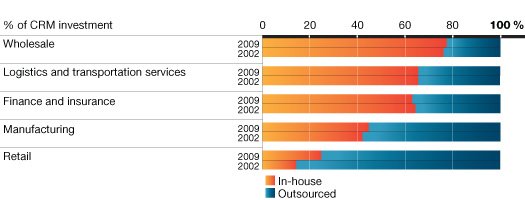
A key aspect of the increase in CRM investment (both total and the in-house portion) by theretail sector has been retailers' integration of CRM activities into their business-to-businessprocesses to improve their sales forecasting and supply chain management through collaborativeplanning, forecasting and replenishment (CPFR). CPFR is an e-based system and joint long term commitment of a retailer, logistics and transportation services provider, and a manufacturerthat links point-of-sale information throughout the retailer's supply chain, enabling the retailer toincrease sales and reduce both stock outs and inventory carried while improving themanufacturer's production planning. Although large retailers originally developed the conceptof CPFR, it is now being adopted across non-consumer product goods supply chains through theuse of forecasting / demand planning software and advanced planning and scheduling (APS).Footnote X,
Outsourced customer relationship management investment forecast
The importance of CRM to firms' competitiveness is expected to remain strong over the nextseveral years across sectors. In particular, the manufacturing sector is forecasted to increase itsCRM outsourced investment by 17 percent between 2009 and 2012, resulting in the sector investingover $20 billion in CRM through service providers in 2012 (Figure 7).
Figure 7—Forecasted outsourced CRM investment (2012) and growth (2009-2012)
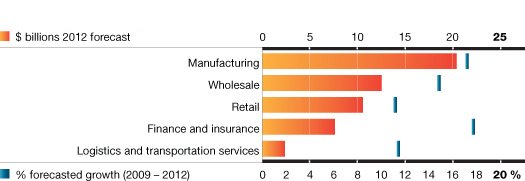
In addition to the manufacturing sector, the finance and insurance sector is also expected to growits outsourced CRM investment significantly over the next several years. A forecasted growth of18 percent between 2009 and 2012 is partially attributable to finance and insurance firms aiming tocapitalize on business opportunities presented by their strong position in the global market.
Customer relationship management service industry
In a customer relationship environment that is rapidly changing due to multi-channelinteractions, media fragmentation and continual market competition, firms are increasinglychallenged to align their marketing, business development, and customer feedback and supportstrategies with evolving customer demands. Manufacturing and services firms often harness theexpertise and experience of CRM service providers into their integrated multi-channel marketing and promotional campaigns, and customized customer feedback and support. In addition, CRM service providers can deliver international market knowledge enabling manufacturing and services firms to tailor their offering to the diverse cultural, social and business styles of targeted foreign markets. Overall, the CRM service industry plays a strategically important role inproviding both CRM expertise and flexibility to firms throughout the CRM cycle.2
The CRM service industry includes many diverse CRM activities. For the purpose of this report, this industry can be categorized into two broad sub-sectors: marketing services and after-sales services. The marketing services sector is engaged primarily in creating, planning and deliveringadvertising, promotion and public relation services to clients, while the after-sales service sectoris primarily engaged in providing customer feedback and support services for their clientsthrough telephone call centres. Overall, the majority of the outsourced CRM service industry is dedicated to providing marketing services, while after-sales services are often contained withinCRM users.Footnote XI 8
Geographic concentration of customer relationship management
In 2008, the majority of CRM service providers were located in central and western Canada withapproximately 2,900 firms in Ontario, 1,800 in Quebec, 800 in British Columbia, and 600 inAlberta.8 The proportion of after-sales service providers compared to marketing services providers is significantly higher in Atlantic Canada (Figure 8).
Figure 8 — Geographic distribution of CRM service providers8
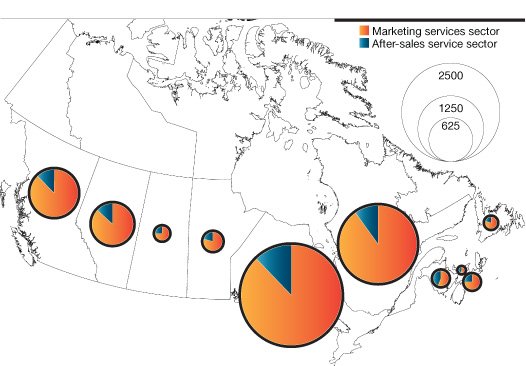
The highest concentrationFootnote XII of CRM service providers were in large metropolitan cities as these service providers are often established near the headquarters of their large corporate clients. The three most CRM concentrated regions were Montréal, Toronto, and Québec City, all of which have strong CRM communities.2, 8
Marketing services sector profile
Specific capabilities within the marketing services sector include creative development, artdirection, copy writing, market research, media production and digital programming. Traditionalareas of outsourcing have included advertisement and promotional campaigns, as these activitiesrequire particular expertise often not available in-house. While key aspects of marketinginitiatives can be sourced through service providers, firms can also benefit from some degree ofin-house marketing capacity. Integrating customer-specific knowledge along with firm-specificbranding and goals into marketing strategies and initiatives are responsibilities typically foundwithin firms at the executive level.2
The Canadian marketing services sector operates mainly in the domestic market, with 94 percent ofrevenue generated in 2008 from Canadian clients. The sector has experienced significant growth over the past several years. In fact, marketing services sector revenue grew 32 percent between 2004and 2008, outpacing the revenue growth of its U.S. counterpart (Figure 9). During this period ofhigh revenue growth, the sector successfully maintained consistent profit margins.9
Figure 9 — Marketing services sector revenue growth9
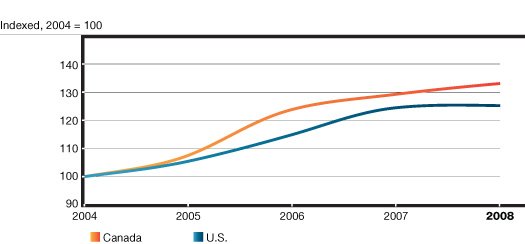
Customer relationship management employment and skills
The CRM process requires a diverse set of skills throughout its three stages. Approximately 502,000 people are employed in CRM occupations within CRM users and the marketing servicessector. When employment is assessed by CRM function, business development positionsoccupy the greatest share for both CRM users and the marketing services sector. Market research and marketing positions are more concentrated within the marketing services providers, while CRM users have a larger proportion of customer feedback and support positions within their organizations (Figure 10).
Figure 10—Employment by CRM function
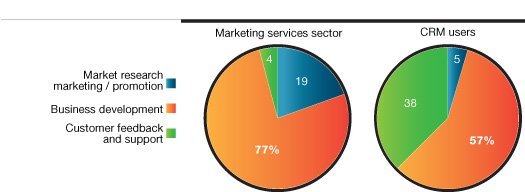
Skill requirements within the CRM process vary among the major business functions. The majority of positions within market research and marketing / promotion, as well as businessdevelopment have medium to high skill requirements (Figure 11).Footnote XIII The training focus for market research, marketing and promotion, and business development has been expanding beyond domestic and traditional CRM activities. Specific areas of emerging skill development include geographic-specific marketing, international market entry strategies, integration of domestic and international trade practices and regulations (i.e. intellectual property, competitionand anti-trust laws, etc.), and global supply chain management.
Figure 11—Skills in CRM occupations (% of employed persons)

Conversely, roles within the customer feedback and support business function are moreoperationally focused. Specific training within this business function varies according to the clientele — industrial / commercial or end consumer. The focus for industrial / commercial customer feedback and support skills development includes logistics and distribution knowledge to respond to replenishment queries. End consumer feedback and support training includes multi-channel communication, language skills development and conflict resolution.
Customer Relationship Management Innovation
To efficiently and effectively respond to rapid changes in customer demand, firms must have access to timely and accurate information regarding their current and potential customers. The integration of CRM technologyFootnote XIV into a greater CRM strategy provides firms with appropriate tools to respond to this challenge. For the purposes of this report, CRM technology includes the ability to:
- Collect customer (or visitor) information online to build a customer (or visitor) database;
- Provide users with the ability to customize the information they see when entering the CRM system;
- Provide online after-sales support for customers; and
- Automatically link to back-end systems within own organization, to customers' systems and to suppliers' systems.
Although adoption of CRM technology across sectors has been limited (Figure 12)Footnote XV, these abilities can provide firms a competitive advantage in the marketplace. For example, the ability to recommend appropriate products to customers can increase the likelihood of a sale. Through proper customer data analysis based not only on their buying patterns but also the patterns ofother customers, firms can improve the effectiveness of product recommendations. Providing the customer with the ability to customize information in a CRM system likely increases their sense of ownership over the customer-supplier relationship and thereby increases customer loyalty as well.
CRM technology has the potential to enhance business operations throughout the sales cycle. The load on service personnel can be reduced through online after-sales support — enablingcustomers to access information themselves, while also automating numerous customer supportprocedures. As well, the automatic communication of data and information between customer facinggroups, back-end operations and a firm's global value chain presents numerous leveragingopportunities across sectors.
Figure 12—Use of CRM technology to manage CRM functionsFootnote XVI, (% of firms)
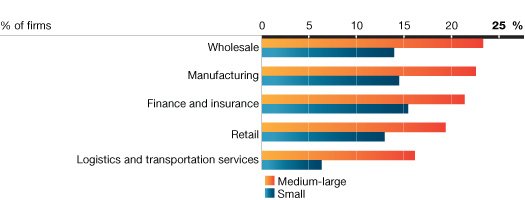
As a firm's business grows, so does the complexity of effectively managing its relationships withcustomers. Providing a consistent, timely, customer-specific message becomes increasinglychallenging as a firm expands to provide products and / or services across multiple channels (in person,telephone, and online) to numerous customers. Thus, larger firms are more likely to bewell positioned to identify business benefits of incorporating CRM technology into their CRM strategies, and ultimately have a greater adoption rate of CRM technology.
In general, of the firms that have adopted CRM technology to manage their CRM functions, the focus has been primarily on gathering customer information and providing online after-salessupport. Within retail, the use of centralized customer and inventory data in CRM systems enables decision makers to introduce optimized initiatives that have an impact on the bottom line. Proper data management allows firms to not only use information to guide future initiatives but also to measure the effectiveness of current loyalty efforts and track the success of up-sellsand cross-sells.
The importance of cross-selling — and ultimately CRM adoption — has been growing within the finance and insurance sector, partly due to the expanding insurance marketplace that nowincludes investment products provided by traditional insurance firms. Also, the finance and insurance sector's end users are now likely to engage a firm through multiple channels, which creates the need for a single, real-time source of customer data.
Global Value Chain integration of customer relationship management technology
One particular focus of firms that have adopted CRM technology has been to link CRM functions to their back-end systems and to suppliers' and customers' systems as well. The integration focus of CRM technology to customers' and suppliers' systems varies among the industry sectors and by the nature of firms' relationships with inbound and outbound supply chain partners (Figure 13). Understandably, customer integration is minimal in retail and financeand insurance, as the "customer" is typically the end consumer.
Figure 13—Integration level of CRM technology functions (% of firms using CRM technology)
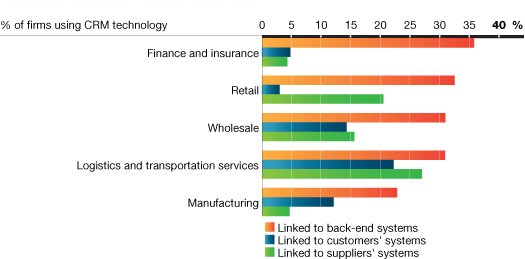
Notably, the manufacturing sector is not one of the most likely sectors to link their CRM technology to their suppliers' systems as manufacturers have a tendency to focus more on production related technology. However, with the growing trend to better respond to industrial and consumer needs, manufacturers' adoption rates of linking CRM technology to their supplychain partners are expected to rise as the importance of supply chain visibility increases.
The business benefits and drivers for firms to link their CRM technology to supply chainpartners vary by sector. For example, increased CRM integration provides manufacturers better supply chain visibility to adjust production schedules to changes in customer demand, and facilitates corporate responsibility processes such as product recall and public safety. Meanwhile, retailers integrate their CRM technology with their suppliers' systems to better manage lead times for product delivery, aiming to reduce both stock outs and inventory carrying costs. Logistics and transportation services providers integrate their CRM technology systems with their suppliers to focus on optimizing fulfillment strategies while lowering their total cost of distribution.
Outsourcing customer relationship management technology functions
The outsourcing of CRM technology involves a firm using a service provider — commonly referred to as an application service provider (ASP) — to manage marketing and customerrelations functions that are implemented using information and communication technologies.The majority of firms utilizing CRM technology to manage their customer relations do sothrough in-house resources. However, of firms using CRM technology, largeFootnote XVII firms are more than twice as likely as medium or small firms to outsource some of their CRM technology functions (Figure 14).
Figure 14—Outsourcing of CRM technology functions, by size of firm

As the ASP outsourcing model requires advanced in-house CRM applications that are mainly used by larger firms, it is expected that large firms are more likely to outsource some of theirCRM technology functions. The ASP model focuses on integrated contact and lead tracking, sales and pipeline management, support ticket and service management, and technical supportmanagement. These advanced CRM applications are designed for and best support multi-site / multi-country and complex sales force operations, mainly present in larger firms.
The amount of outsourcing of CRM technology functions varies by industry sector. The finance and insurance sector has added security concerns due to the large amount of personal informationthat is contained within customer files, which contributes to the limited amount of outsourcingperformed within the sector. Meanwhile, with the increased need to develop CPFR supply chain platforms, retail and wholesale firms have the highest rate of outsourcing CRM technology functions.
Best-in-Class Analysis
This section examines how Best-in-Class (BiC) firms compare to Laggards regarding their use of performance measurement in CRM, their CRM organizational and knowledge processes alongwith their CRM business development technology adoption. BiC firms are defined as NorthAmerican businesses that achieve positive results in five key year-over-year performancecriteria: average deal size, average annual customer revenue, sales cycle time, time to quota, andsales administration time. BiC firms represent those North American businesses that constitute the top 20 percent of aggregate performance scorers while the Laggards constitute the bottom 30 percent.
CRM performance measurement
Tracking performance such as sales cycle time, customer retention and forecast accuracyprovides BiC firms with the ability to promptly identify issues in their CRM process and takeany necessary action (Figure 15). Key performance indicator (KPI) measurement also allowsBiC firms to monitor progress of their customer relations initiatives and their return on investment (ROI) in CRM on an ongoing basis. Furthermore, once performance is being measured a firm can set performance targets — a key link between strategy and day-to-day operations.
Figure 15—BiC CRM key performance indicators (KPI) measurement (% of firms)

CRM business development technology adoption
The adoption of business development technology beyond individual contact management andmulti-module CRM distinguishes BiC firms. Enabling sales forces to benefit from a structuredmethod of sourcing new business is a key BiC strategy. For example, employing a well throughout approach to manage leads allows sales teams to efficiently pursue business opportunities anddecrease sales cycle times. In particular, BiC firms are more than twice as likely to utilize leadmanagement solutions and CRM collaboration tools (Figure 16).
Figure 16—BiC business development technology currently in use (% of firms)

CRM organizational and knowledge processes
BiC firms not only excel in CRM performance measurement and technology adoption but alsoshare similar priorities and excellence in their process, organizational, and knowledgemanagement (Figure 17). The advancement of web-based business opportunities has increasedthe likelihood that a customer will have multiple touch points with a supplier: with the customerable to interact with the supplier often either in-person, over the phone, or online, the importanceof creating a single source of up-to-date customer data is emphasized. Leveraged use of centralizedcustomer and inventory data in CRM systems enables firms to optimize initiatives that impact the bottom line through sales force optimization, increased predictability of revenue flows, customized service for customers, reduced unnecessary discounting, maximized profitable customer loyalty, and reduction in customer acquisition / retention and recovery costs.
Figure 17—BiC CRM processes for organizational and knowledge management (% of firms)
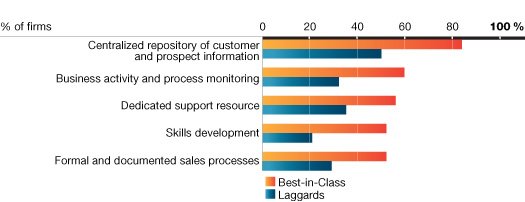
The use of a formalized sales process increases the chances of a sale by ensuring that thecustomer is presented a consistent message along established timelines. Having dedicated salessupport resources enables a sales force to commit more time to selling rather than administrativeneeds. Finally, BiC firms are 2.5 times more likely than laggards to utilize skills development to drive their competitiveness.
Final Remarks
CRM plays a vital role in the commercialisation of manufactured goods and services. It is a critical process utilized by firms to manage and develop their relationships with current andpotential customers. To maximize benefits from innovative CRM processes and activities,individual firms should develop their own specific business cases and action plans consisting of along-term vision, KPIs, return on investment targets and project time frames.
Overall, the CRM process is an integral business function both within CRM users and their service providers employing 502,000 workers and accounting for $116 billion in investment inthe manufacturing, wholesale, retail, finance and insurance, and logistics and transportationsectors.
The BiC analysis identifies specific CRM processes including skills development, innovation,technology adoption and KPI measurements implemented by BiC firms. BiC firms distinguish themselves by improving average deal size, average annual customer revenue, sales cycle time, time to quota, and sales administration time.
The findings in this report present important linkages between commercialisation, investment inCRM, innovation, skills development, and resulting business benefits. These connections can help inform a continued dialogue across businesses, governments and academia. This report alsosets the stage for those interested in commercialisation and CRM trends to pursue new research and analysis opportunities.
Annex I — Tables
Customer relationship management investment
| In-house | Outsourced | Total | |
|---|---|---|---|
| Wholesale | 37.85 | 10.80 | 48.65 |
| Manufacturing | 13.71 | 17.27 | 30.97 |
| Finance and insurance | 11.19 | 6.55 | 17.73 |
| Retail | 3.19 | 9.68 | 12.87 |
| Logistics and transportation services | 3.93 | 2.08 | 6.01 |
| Total CRM Users | 69.86 | 46.38 | 116.24 |
| In-house | Outsourced | Total | |
|---|---|---|---|
| Wholesale | 8.0% | 2.3% | 10.3% |
| Finance and insurance | 4.6% | 2.7% | 7.3% |
| Logistics and transportation services | 3.4% | 1.8% | 5.1% |
| Manufacturing | 2.1% | 2.7% | 4.8% |
| Retail | 0.7% | 2.3% | 3.0% |
| Total CRM Users | 3.7% | 2.4% | 6.1% |
Customer Relationship Management Technology Adoption
| Small 1-19 employees | Medium-large 20+ employees | |
|---|---|---|
| Wholesale | 14% | 24% |
| Manufacturing | 15% | 23% |
| Finance and insurance | 16% | 22% |
| Retail | 13% | 20% |
| Logistics and transportation services | 6% | 16% |
| Small 1-19 employees | Medium-large 20+ employees | |
|---|---|---|
| Finance and insurance | 10% | 17% |
| Manufacturing | 10% | 16% |
| Retail | 9% | 15% |
| Wholesale | 10% | 15% |
| Logistics and transportation services | 4% | 14% |
| Small 1-19 employees | Medium-large 20+ employees | |
|---|---|---|
| Finance and insurance | 5% | 14% |
| Wholesale | 4% | 9% |
| Logistics and transportation services | 2% | 7% |
| Retail | 3% | 7% |
| Manufacturing | 3% | 6% |
| Small 1-19 employees | Medium-large 20+ employees | |
|---|---|---|
| Wholesale | 9% | 15% |
| Finance and insurance | 10% | 11% |
| Manufacturing | 8% | 11% |
| Retail | 5% | 10% |
| Logistics and transportation services | 3% | 8% |
| Linked to back-end systems | Linked to customers' systems | Linked to suppliers' systems | |
|---|---|---|---|
| Finance and insurance | 36% | 5% | 4% |
| Retail | 33% | 3% | 21% |
| Wholesale | 32% | 15% | 16% |
| Logistics and transportation services | 31% | 23% | 27% |
| Manufacturing | 23% | 12% | 5% |
| Small 1-9 employees | Medium-large 20+ employees | |
|---|---|---|
| Retail | 12% | 21% |
| Wholesale | 13% | 19% |
| Manufacturing | 13% | 12% |
| Finance and insurance | 7% | 6% |
| Logistics and transportation services | 2% | 5% |
| Small | Medium | Large | |
|---|---|---|---|
| Small = 1-19 employees Medium =20-99 (in services), 20 to 499 (in manufacturing) Large = 100+ (in services), 500+ (in manufacturing). | |||
| Private sector | 11% | 15% | 35% |
Annex II — Definitions
- Collaboration tool:
- technology-based system or method to automate information sharingbetween groups to generate business development presentations, tenders and proposals.
- Cross-selling:
- a business development technique in which certain additional products arerecommended based on what a customer is purchasing.
- Forecasting / demand planning software and advanced planning and scheduling (APS):
- management practices and technology that optimize production plans and schedules to meetdemand based on available materials, labour and plant capacity.
- Individual contact management:
- sales automation tools enabling individuals to manage contacts,leads, business opportunities, and account information.
- Lead management solution:
- technology-based system or process to structure how a firm sourcesnew business. It also coordinates and tracks past interactions and communications with leads,helping the leads to move through the pipeline faster and ultimately reducing sales cycle time.The system also enables a firm to track and forecast business development leads.
- Multi-module CRM:
- technology tools that provide a system of record for all customerinteractions utilized by all customer facing groups to provide an organization a comprehensiveand uniform perspective of current and potential customers.
- Sales cycle time:
- time between the first contact with a client or customer and the sale.
- Stockout:
- a situation where demand for an item cannot be fulfilled from the current (on-hand)inventory.
- Up-selling:
- selling something that is more profitable or otherwise preferable for the seller insteadof the original sale.
Footnotes
- Footnote 1
CRM technology: CRM business processes operationalized by the structured exchange and management of information over networks using Internet architecture. These systems are also referred to as Internet business solutions. The network can be open (e.g. accessible to everyone through the World Wide Web) or closed (e.g. accessible only to employees or suppliers on a LAN or WAN ).
- Footnote 2
CRM investment includes manufacturing, wholesale, retail, logistics and transportation and finance and insurance industries. Employment includes CRM roles within those industries and the marketing services sector
- Footnote 3
Concentration is defined as the number of CRM service providers divided by the total number of all business establishments in a geographical location.
- Footnote 4
Best-in-Class firms are defined as the top 20 percent of North American firms benchmarked to improvement in five performance metrics: average deal size, average annual customer revenue, sales cycle time, time to quota, and sales administrative time.
- Footnote 5
For an in-depth look at product design and development, see Industry Canada's report entitled State of Design: The Canadian Report 2010.
- Footnote 6
For an in-depth look at logistics and distribution, see Industry Canada's report entitled State of Logistics: The Canadian Report 2008.
- Footnote 7
SME manufacturers are defined as manufacturers with between 20 and 500 employees and $250,000 or more in annual revenue.
- Footnote 8
For a detailed breakdown of CRM investment volume, see Annex I.
- Footnote 9
CRM investment intensity is defined as CRM investment divided by sales. For a detailed breakdown of CRM investment intensity see Annex I.
- Footnote 10
For further information on CPFR, see Industry Canada's report entitled State of Retail: The Canadian Report 2010
- Footnote 11
CRM users include manufacturing, wholesale, logistics and transportation, retail, and finance and insurance industries.
- Footnote 12
Concentration is defined as the number of CRM service providers divided by the total number of all business establishments in a geographical location.
- Footnote 13
High skill defined as occupations usually requiring university education, medium skill occupations usually require college education or apprenticeship training, and low skill occupations usually require secondary—school and / or occupation-specific training.
- Footnote 14
CRM technology is defined as CRM business processes operationalized by the structured exchange and management of information over networks using internet architecture. These systems are also referred to as Internet business solutions. The network can be open (e.g. accessible to everyone through the World Wide Web) or closed (e.g. accessible only to employees or suppliers on a LAN or WAN.
- Footnote 15
For a detailed breakdown of CRM technology adoption, see Annex I.
- Footnote 16
Small = 1-19 employees, Medium-large = 20 +.
- Footnote 17
Small = 1-19 employees, Medium = 20-99 (in services), 20 to 499 (in manufacturing), Large = 100 + (in services), 500 + (in manufacturing).
Permission to reproduce:
Non-commercial Reproduction
Except as otherwise specifically noted, the information in this publication may be reproduced, in part or in whole and by any means, without charge or further permission from Industry Canada, provided that due diligence is exercised in ensuring the accuracy of the information reproduced; that Industry Canada is identified as the source institution; and that the reproduction is not represented as an official version of the information reproduced, nor as having been made in affiliation with, or with the endorsement of Industry Canada.
Commercial Reproduction
For permission to reproduce the information in this publication for commercial purposes,
please contact the:
Web Services Centre
Industry Canada
C.D. Howe Building
235 Queen Street
Ottawa, Ontario Canada
K1A 0H5
Telephone (toll-free in Canada): 1-800-328-6189
Telephone (Ottawa): 613-954-5031
Fax: 613-954-2340
TTY (for hearing-impaired): 1-866-694-8389
Business hours: 8:30 a.m. to 5:00 p.m. (Eastern Time)
Email: ic.info-info.ic@canada.ca
© Her Majesty the Queen in Right of Canada,
represented by the Minister of Industry, 2010
IC# 60815
Cat. No.: Iu44-82/2010
ISBN: 978-1-100-52362-0
Aussi offert en français sous le titre L'état de la gestion de la relation client : Le rapport canadien 2010
